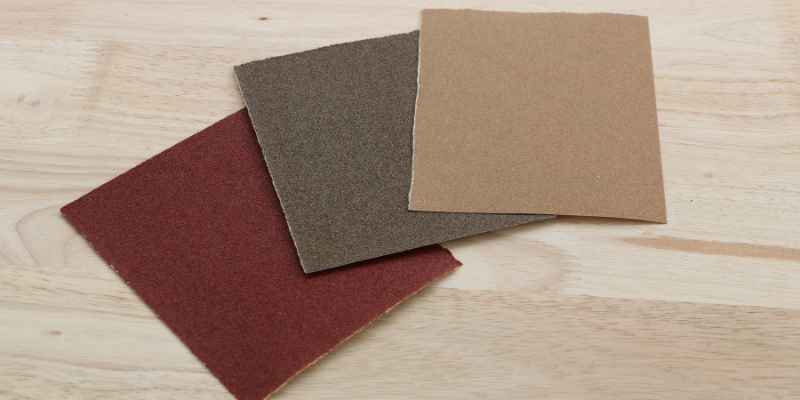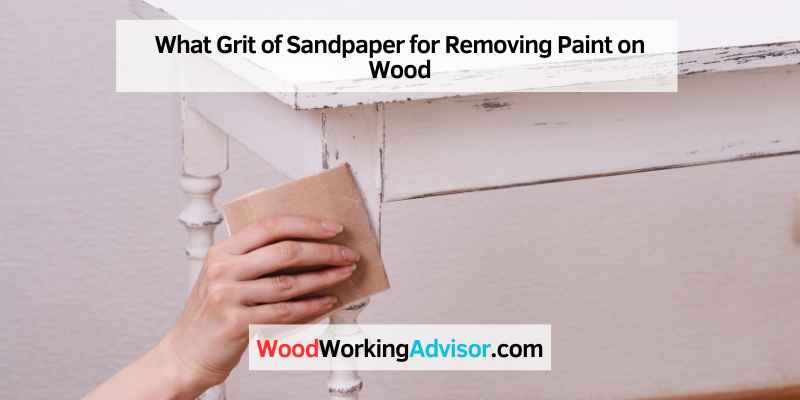For removing paint on wood, use 60-80 grit sandpaper. Sandpaper with lower grits have rougher surfaces, making them more effective in removing paint quickly but leaving rougher marks on the wood.
Higher grit sandpapers remove paint gradually and leave the wood surface smoother, but they do so slowly. Removing paint on wood requires the right sandpaper grit. Sanding is a crucial process in preparing wood for a new paint job, staining, or restoring it to its original glory.
Knowing the right sandpaper grit to use will save you time and effort while giving you the desired results. Sandpaper grits range from coarse to fine. Coarser grits remove paint faster but leave rougher surfaces, while finer grits remove paint gradually but leave the wood surface smoother. We will look at the best sandpaper grit for removing paint on wood.
Understanding Sandpaper Grits
To effectively remove paint from wood, it is important to choose the right grit of sandpaper. Generally, a coarse grit of 60-80 is recommended for initial removal, followed by a finer grit of 100-120 for smoothing. However, the specific grit required may vary depending on the type and thickness of the paint.
Different Types Of Sandpaper Grits
Sandpaper grits come in various grades, each having a different purpose. Understanding these grades is essential to ensure that you use the correct sandpaper to remove paint from wood. Generally, sandpapers are categorized into four types depending on their grit size: coarse, medium, fine, and extra-fine.
How Sandpaper Grits Are Measured
Sandpaper grit size is measured using a standard called the CAMI (Coated Abrasive Manufacturers Institute) scale. The scale usually ranges from 24 (coarsest) to 1,000 (finest), although some manufacturers may offer grits above or below this range. A higher grit number indicates a smaller abrasive particle size, which makes the sandpaper less aggressive and more suitable for finer finishing works.
How Grit Affects Sanding Performance
Grit size plays a crucial role in determining the sanding performance of your sandpaper. A lower grit sandpaper (below 80) is coarse and removes more material from the surface, making it ideal for removing thick layers of paint or varnish. In contrast, a higher grit sandpaper (above 120) is smoother and more delicate on the surface. It’s perfect for removing paint residue or preparing the surface for finishing.
In conclusion, understanding sandpaper grits is crucial in selecting the right sandpaper for your woodwork project. While coarse sandpapers can save you time by removing paint layers quickly, using a fine sandpaper can give your wood surface a smooth and even finish. Therefore, take time to understand the task at hand and select the sandpaper grit that suits your specific needs.
Preparing The Surface
When removing paint from wood, it’s important to prepare the surface by using sandpaper with the proper grit level. Typically, 60 or 80 grit sandpaper are good options, but it ultimately depends on the thickness and type of paint you’re trying to remove.
Inspecting The Wood For Painting
Before you start removing paint from wood, it’s important that you inspect the surface of the wood to ensure there are no damages or nails that can ruin the sandpaper. Look for cracks, dents, and holes that might affect the process and make the sanding work challenging. If you find any nails or tacks, remove them to avoid damaging the sandpaper.
Cleaning The Surface
After inspecting the wood, the next step is to clean the surface of the wood. Get rid of loose paint, dirt, and dust with a clean cloth or brush. If the surface is too dirty, use soapy water to clean it thoroughly. Once you have cleaned the wood, allow it to dry before sanding.
Wet Sanding Vs. Dry Sanding
When it comes to sanding paint off of wood, you have two options – wet sanding or dry sanding. Wet sanding involves using water to lubricate the sandpaper to avoid clogging. This method is ideal for removing rough patches and paints with a high grit. Dry sanding, on the other hand, is best for removing old paint layers, and it doesn’t require water. It’s important to note that you should wear protective gear when sanding painted wooden surfaces, especially when dry sanding to avoid inhaling the paint particles.
Before you start sanding, you need to select the appropriate grit of sandpaper. For removing paint from wood, you should start with coarser sandpapers like 60 or 80 grit to remove the top layer of paint. Follow these with sequentially finer grits – 120, 150, and 220 to smoothen the surface.
Properly preparing the surface is essential to ensure a smooth and flawless finish when removing paint from wood. By carefully inspecting the wood, cleaning it thoroughly, and selecting the appropriate grit of sandpaper, you’ll be able to easily remove paint from wooden surfaces with ease and achieve the desired outcome.
Best Sandpapers For Removing Paint From Wood
To remove paint from wood, use sandpaper with a grit of 80 to 120 for the initial removal process, followed by a finer grit of 150 to 180 for smooth finishing. Be sure to choose the best quality sandpaper as it can make all the difference in achieving a desirable result.
Removing paint from old wooden surfaces is never an easy task, but with the right tools and techniques, you can get results that are worth the effort. One of the essential tools you need is sandpaper, but not all sandpapers are created equal. When choosing sandpaper for removing paint, the grit size is the most crucial factor to consider. Here are the best sandpapers for removing paint from wood.
60 To 80 Grit Sandpaper
If you want to remove several layers of paint, the 60 to 80 grit sandpaper is your best bet. This coarse grit sandpaper is effective in getting rid of thick and stubborn paint layers. However, it can be overly aggressive and could damage the wood if you apply too much pressure. Start with a lighter touch, gradually increasing pressure with each pass.
100 To 150 Grit Sandpaper
The 100 to 150 grit sandpaper is ideal for removing the remaining paint after using 60 to 80 grit sandpaper. This medium grit sandpaper effectively smooths out rough spots and removes leftover paint. It’s also gentle enough to ensure that the wood surface remains unscathed.
220 Grit Sandpaper
The 220 grit sandpaper is the finest grit sandpaper you should use for removing paint from wood. It’s perfect for smoothing out the wood surface before applying new paint or stain. It’s also useful for removing small paint spots and ensuring that the surface is even.
When using sandpaper to remove paint, remember to use light, even pressure, and avoid sanding the same spot for too long. Always sand in the direction of the grain. If you follow these tips and choose the right sandpaper for the job, you’ll have a smooth, paint-free wood surface in no time.
Choosing The Right Sander

Removing paint from wood requires a sander with appropriate grit sandpaper. Coarse grits like 60 or 80 are ideal for removing old paint, while fine grits like 220 or higher help to smoothen the surface. It’s essential to choose the right sander and sandpaper to obtain a smooth, prepped surface.
When it comes to removing paint from wood, choosing the right sander plays a crucial role in achieving a smooth and even surface. Sanders come in various shapes and sizes and picking the correct one can save time and ensure proper paint removal. Here’s an overview of sanders for removing paint on wood, factors to consider when choosing a sander, and the best sanders for removing paint on wood.
Overview of Sanders for Removing Paint on Wood:
There are three main types of sanders used for removing paint on wood: orbital sanders, belt sanders, and detail sanders. Orbital sanders are ideal for small to medium-sized surfaces and are the most commonly used sander. Belt sanders, on the other hand, are used for large surfaces and can remove paint quickly. Detail sanders are designed to reach tight spots and are suitable for intricate surfaces.
Factors to Consider when Choosing a Sander:
When choosing a sander, several factors are worth considering. These factors will help in selecting the right sander suitable for your project. They include:
– Surface area to be sanded
– Type of wood
– Your skill level
– Dust collection capability
– The weight of the sander
The Best Sanders for Removing Paint on Wood:
There is a range of sanders available, making it challenging to choose the best for your project. However, the following sanders are the best for removing paint on wood:
– Makita BO5041K Random Orbital Sander – Best Overall
– DEWALT DWE6423K Random Orbital Sander – Best for Large Surface Area
– Bosch ROS20VSC Palm Sander – Best Budget-Friendly Option
– TACKLIFE Belt Sander – Best for Paint Removal on Vertical Surfaces
Conclusion:
Choosing the right sander for removing paint on wood plays a vital role in achieving a smooth and even surface. By taking into account the surface area to be sanded, type of wood, skill level, dust collection capability, and the weight of the sander, users can select the best tool for their project. The Makita BO5041K, DEWALT DWE6423K, Bosch ROS20VSC, and TACKLIFE Belt Sander are the best sanders for removing paint on wood, each with its unique features and benefits.
Other Methods To Remove Paint
Removing paint from wood can be done using different methods other than sandpaper, such as a heat gun, chemical paint strippers, or scraping. However, if you choose to use sandpaper, it is recommended to start with a coarse grit, such as 60 or 80, to remove the paint’s surface layer before moving on to a finer grit for a smoother finish.
If you are dealing with a large surface area or multiple layers of paint, removing it with sandpaper might not be the most efficient option. In such cases, you might want to consider other methods such as chemical strippers, heat guns, or power washing.
Chemical Strippers
Chemical strippers are a popular and effective way to remove paint. They work by softening the paint and breaking its bond with the surface. Most chemical strippers come in a gel or liquid form and are applied with a brush or spray. After a set time, the paint will start to blister and can be easily scraped off with a putty knife or scraper. Be sure to follow the manufacturer’s instructions, wear protective gear, and work in a well-ventilated area when using chemical strippers.
Heat Gun
A heat gun is another method of removing paint that is particularly useful when working on intricate woodwork or surfaces with hard-to-reach areas. Heat guns work by softening the paint with a high temperature, making it easy to scrape off with a putty knife or scraper. However, be careful not to overheat the wood, as the wood can burn or scorch.
Power Washing
Power washing is a good option when removing paint from large areas, such as fences or decks. It works by using a high-pressure stream of water to blast the paint off the surface. However, it can be messy and might require additional prep work to protect nearby areas from the water and debris.
In conclusion, sanding with the right grit sandpaper is a popular way to remove paint from wood, but it might not always be the best option depending on the project. Other methods such as chemical strippers, heat guns, or power washing can be more efficient and effective depending on the situation. As always, be sure to wear protective gear and follow safety precautions when working with power tools or chemicals.
How To Sand Wood For Painting
To remove paint from wood, it’s important to use the right grit of sandpaper. Typically, a coarse grit like 60 or 80 is best for initial paint removal, while a finer grit like 120 or 150 can be used for a smoother finish.
Make sure to wear protective gear and sand in the direction of the grain for optimal results.
The Importance Of Sanding For A Smooth Finish
Sanding wood is a crucial step in painting projects, as it helps to create a smooth surface for the paint to adhere to. Before applying paint, it is essential to remove any existing finish, such as varnish, stain, or paint, from the wood surface. Removing it with sandpaper is the most effective way to ensure proper paint adhesion and a more professional-looking finish. Sanding also helps to reduce the appearance of scratches and imperfections on the wood surface.
Sanding Techniques For Unpainted And Painted Wood
When sanding wood for painting, it is essential to select the right type of sandpaper. The right grit sandpaper for removing paint from wood is either 60 or 80 grit. Coarse sandpaper, such as 40 grit, can damage the wood surface, while a finer grit, such as 120 grit, may not remove the old paint effectively. The recommended technique for sanding unpainted wood is to start with a coarse sandpaper and gradually work your way to a finer grit. For painted surfaces, use a fine grit sandpaper to avoid damaging the underlying layer of paint.
Tips For Sanding Large Surfaces
Sanding large surfaces can be challenging, but there are a few tips that can make the process easier. Firstly, using an orbital or belt sander can help reduce the amount of time and effort required to sand large areas. Start with a coarse grit sandpaper and work your way to a finer grit, ensuring you move the sander in the direction of the wood grain. It is also important to periodically check the sandpaper for wear and tear and replace it if necessary.
In conclusion, sanding wood for painting is a crucial step that should not be overlooked. By using the right type of sandpaper and techniques, you can achieve a smooth and professional finish. Remember to invest in high-quality sandpaper and check it regularly for wear and tear, especially when dealing with large surfaces.

Frequently Asked Questions For What Grit Of Sandpaper For Removing Paint On Wood
What Grit Sandpaper To Remove Paint From Wood?
To remove paint from wood, you should use sandpaper with a 60 or 80 grit.
Will 120 Grit Sandpaper Remove Paint?
Yes, 120 grit sandpaper can remove paint from wood, but it may not be the most efficient option and can potentially damage the wood if too much pressure is applied. Using a lower grit such as 60 or 80, or using a paint stripper may be a better option depending on the paint type and the condition of the wood.
What Is 220 Grit Sandpaper Used For?
220 grit sandpaper is used for smoothing surfaces, removing minor blemishes, and preparing surfaces for finishing. It is also used for removing old finishes and preparing surfaces for new ones.
What Sandpaper To Sand Down Paint?
To sand down paint on wood, the best grit sandpaper to use would be either 60 or 80. It’s important to use the proper grit sandpaper, as too fine of a grit won’t effectively remove the paint and too coarse of a grit can damage the wood.
Additionally, using a sander may make the job easier and faster.
Conclusion
Based on our discussion, it is clear that selecting the right grit sandpaper is crucial when removing paint from wood. The grit size will determine how smoothly and efficiently you remove the paint without damaging the wood. Additionally, it is important to consider the condition of the wood and the type of paint you are removing.
With the right tools and techniques, paint removal on wood can be a breeze. Keep in mind that safety should always be a priority, so wear protective gear and work in a well-ventilated area. Happy sanding!


